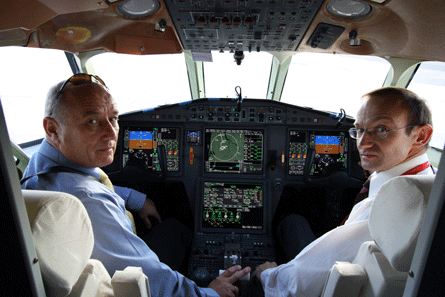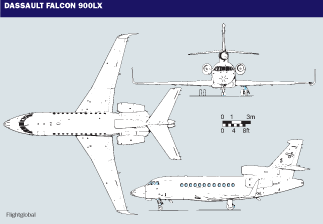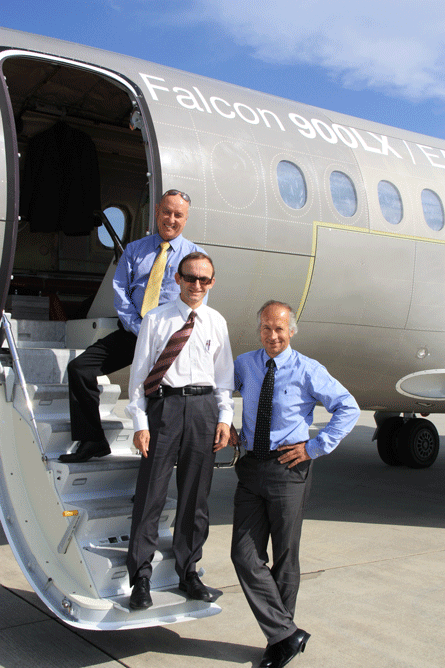The evaluation aircraft was an 900LX, registered F-WWFB, a new production model still in its primer
Dassault has just completed the update of its business jet product line with the joint European/US certification of the Aviation Partners winglet-modified Falcon 900LX.
The Falcon 900LX is an upgrade of the Falcon 900EX and becomes the new production standard of this model. The 4,750nm (8,790km)-range 900LX joins the Falcon winglet family alongside the 4,000nm-range 2000LX and the 6,000nm-range Falcon 7X.
The fully blended winglets for the 900LX are the same as those fitted to the 2000LX, curving gracefully to rise 1.67m (5.5ft) above the wing and increasing the (effective) wing span by just over 2m on each side.
 |
|---|
© Dassault |
The wings of the 900LX and the 2000LX are identical in size, shape and section but because the 22,225kg (49,000lb) maximum take-off weight of the 900LX is increased compared with the 19,160kg MTOW of the 2000LX, the 900LX winglets require a small amount of additional internal wing reinforcement, making the winglet modification weigh 160kg (compared with115kg for the 2000LX). Because of the stronger 900LX wing reinforcement required, Aviation Partners is considering the feasibility of winglet retrofit on to older 900EXs to upgrade them to LX standard.
INCREASED RANGE
Importantly, however, the winglets require no flightdeck changes, increase the aircraft's range by 5% up to 4,750nm (compared with 4,500nm for the 900EX) and allow the 900LX to climb directly to FL390 at MTOW in up to ISA +10°C conditions (compared with ISA +2°C for the 900EX).
They also markedly reduce noise in all take-off/climb segments while meeting the same required take-off/climb gradients, which is now a critical additional performance parameter in urban environments such as London City airport, and where 900LX steep approach certification is set for summer 2011.
In addition, the winglets offer a substantial increase in lift and reduction in stall speeds that could have been used to reduce approach and landing VREF speeds. The 900LX has a quoted approach indicated airspeed of 110kt (205km/h) and a landing distance of 655m at sea level, with six passengers and two crew, NBAA IFR reserves and equating to an assumed aircraft weight of 13,150kg. Dassault, however, chose not to take credit for that, so performance tables and aircraft manuals for the 900LX and the 900EX remain identical.
 |
|---|
© DassaultTest pilot Peter Collins (left), with Fred Lescourreges (right) - The EASy glass cockpit has pilot information and is "simple to interpret, manage and configure" |
Like the 2000LX, the joint Dassault/API test programme has introduced slight changes to the 900LX aileron "droop" and longitudinal (pitch) elevator control "feel" system, but these handling changes are transparent to even an experienced 900EX pilot, says Dassault.
The 900LX uses the same fuselage barrel as the 2000LX, giving the same cabin dimensions of 235cm (92in) cabin width and 188cm cabin height, but with an increased length of 10.1m compared with just under 8m for its shorter-range sibling's cabin. The 900LX VMO remains at an indicated airspeed of 370-350kt (altitude dependent) and MMO remains at Mach 0.87-0.84 (altitude dependent).
Maximum operating altitude is 51,000ft. The aircraft is powered by three Honeywell TFE731-60s each developing 5,000lb (22.2kN) of uninstalled thrust (flat rated up to 32°C/89.6°F). The centre engine has a thrust reverser.
Highly significant is that the 900LX retains the basic operating weight of 11,235kg and the maximum landing weight of 20,185kg (which is therefore just 2,040kg less than its MTOW of 22,225kg) but the winglets now allow the jet to take off from Paris with six passengers, perform a short hop to land in London and then continue on to New York - without refuelling.
Dassault says that no other business jet in the 900LX category offers the owner/operator such unrivalled operational flexibility and this is allied to a 40-60% reduction in fuel burn, over the same range with the same load, when compared with its nearest rivals.

Even more illuminating is to compare the 900LX operating weights to those of the Bombardier Global Express or Gulfstream G550 series types. These are longer-range aircraft when required, but are typically more often used over similar (if not shorter) transatlantic type distances. These types have basic operating weights of around 24,970kg, maximum landing weights of roughly 34,000kg (precluding a short-hop/long-range Paris-London-New York unrefuelled journey combination) and take-off weights of about 40,860kg for such a transatlantic flight with six passengers.
COMMERCIAL ADVANTAGE
For a prospective business jet buyer, the operational, performance, economy and emission figures give the 900LX a commercial advantage when the aircraft is compared with its direct market competitors or when operating in the real world of corporate aviation.
My test objective was simple: conduct a quick-look assessment of the 900LX at high, medium and low levels and fly the aircraft "aggressively" to evaluate the influence (if any) of the winglet modification on the handling characteristics.
The evaluation aircraft was an 900LX, registered F-WWFB, a new production model still in its primer. The assessment was to be only its third flight before it was transferred to Little Rock, Arkansas later that week.
The basic operating weight was 11,030kg and with 4,090kg of fuel, giving a take-off weight of 15,120kg with mid-centre of gravity. The assessment flight was to depart and land at the Dassault test facility at Bordeaux, but with instrument landing system, visual circuits, rollers and go-arounds performed at La Rochelle, airfields with close to ISA conditions and with CAVOK weather.
My safety pilots were Fred Lascourreges (Falcon 900LX programme test pilot), in the right-hand seat and Philippe Deleume (Dassault chief test pilot), on the central jump seat. I would fly the complete evaluation from the left-hand seat.
 |
|---|
© DassaultTest pilot Peter Collins (left), with Fred Lescourreges (middle) and Philippe Deleume (right) |
Lascourreges completed the initialisation of the EASy cockpit and all checklists were electronic. I marvelled at the EASy as it is such a superb, totally glass cockpit, bursting with pilot information and yet so simple to interpret, manage and configure without it ever feeling cluttered. The EASy II cockpit is to be launched shortly.
The pilot flying display features a flightpath vector (FPV) symbol as its aircraft reference, rather than aircraft pitch attitude, with the FPV locked laterally to act as a climb/dive angle.
Take-off at Bordeaux was with slats/flap 1, a V1 indicated airspeed of 110kt, VR 117kt and V2 117kt. Engine acceleration was rapid on the take off with idle to full power just taking 3-4s.
After rotate, we settled into a 20° FPV climb at an indicated airspeed of 180kt and with the aircraft in this configuration feeling like a rocket ship. Converting to 260kt and then M0.75, even with air traffic control constraints, allowed us to reach FL410 in 13min.
In the climb I had time to assess the aircraft's control mechanical characteristics and some lateral and directional stability points. I immediately liked the small throttles, their short range of travel and the accuracy with which I could manually set a precise power.
Yoke breakout was small but precisely defined; freeplay was zero; lateral centring was absolute. Small lateral control inputs to capture approach type bank angle targets precisely were accurate and easy to achieve; roll control forces were low at all speeds/altitudes and roll control power was high so that at 250kt, a one-third lateral yoke input generated a sustained roll rate of 45°/s and at 210kt (just below VA), a full yoke deflection generated a rate of 70-80°/s.
Even with full and rapid lateral yoke inputs, no adverse yaw was noted at the start of the roll. The aircraft always rolled promptly in the direction of applied rudder and at FL410 the Dutch roll was convergent with the yaw damper manually disengaged.
At FL410, M0.82, a 55° level banked turn was sustained with no hint of wing buffet. A 70° banked spiral was then initiated to descend manually from FL410 to FL150, first at MMO and then converting to VMO at around FL250.
Airbrake (wing spoiler) positions AB1 and AB2 were selected and deselected several times in rapid steps during the descent to generate a descent rate in excess 10,000ft/min (50.8m/s) and to try to destabilise the wing while playing the pitch and bank angles to maintain MMO and then VMO.
Throughout the descent the 900LX felt completely predictable and responsive, at both high and medium flight levels, despite this aggressive manual manoeuvring and with no change in control forces and without excess vibration or buffet.
At FL150 we set up quickly for approach to stall in both clean and landing (SF3) configurations. Because we were not a test-configured aircraft and were without airframe stress gauges, both stall approaches (clean-minimum approach to stall speed 112kt and SF3-minimum approach to stall speed 92kt) were taken beyond the pilot flying display visual indications and the initial aural warning of "increase speed", but terminated at the aural warning of "stall" (rather than go further to the actual stall g-break or nose-down pitch point).
The aircraft remained fully responsive in roll during the approach to stall, there was no tendency to yaw off as speed decreased and the very light aerodynamic buffet felt was symmetrical.
Next we descended to fly an all-engines instrument landing system approach to La Rochelle Runway 27, with a break off to go visual and circle to roll Runway 09. This was followed by second visual circuit to Runway 09 as an asymmetric 2 engine (the No 3 right-hand engine placed at idle) circuit to low go-around from 200ft above the ground with asymmetric full power set on engines No 1 and No 2 during the go-around climb.
The third, and final, all-engines visual circuit to Runway 09 was with a massive lateral offset of around 200m at 200ft above the ground (left of centreline), to replicate a poor precision approach "delivery", then S-bending to a low go-around at 50ft above the Runway 09 surface.
The crosswind at La Rochelle was 160°/35kt at 1,000ft and 160°/25kt at the surface. The circuits were flown manually with a combination of manual and autothrottle power control and manual or autopilot speed control so I could assess whether there was a need to keep some "automatics" with me in the circuit.
During the crosswind roller on the first circuit the aircraft was "crabbed" on approach, with the left rudder input to precisely "kick off drift" in the flare being simple to achieve and accurate to control into a soft touchdown.
The second circuit required a 20% left rudder trim selection to balance the slip and on go-around, the asymmetric power compensation required by rudder input was small and instinctive for the pilot to apply.
The massive lateral offset manoeuvre on the third circuit down to a simulated landing was far beyond the normal limits of any commercial operation, yet the jet coped without problem to be lined up for the simulated landing flare.
The combination of delightful handling and powerful flight-control characteristics, rapid and accurate power response, the EASy cockpit information and the FPV on the pilot flying display providing intuitive flightpath information irrespective of speed/configuration meant I found myself enjoying the simple pleasure of flying the aircraft fully manually and without any back up from autothrottle or autopilot functions. I felt this aircraft was as responsive to fly in the circuit/on-approach as a military advanced jet trainer, if the pilot ever needed that capability.
On return to Bordeaux we shut down after a 1h 50 min flight with 2,225kg fuel remaining, meaning we had used just 1,865kg of fuel in nearly 2h of hard manoeuvring flight.
The 900LX flying characteristics were, in my opinion, almost identical to those of the 2000LX and close to faultless. The 900LX is the best handling and most rewarding conventionally controlled business jet I have flown.
PERFECT UPGRADE
The winglet modification is a perfect upgrade for the Falcon 900LX and one that is in complete aerodynamic synergy with the aircraft.
Dassault continues to develop aircraft that are a real pleasure for any pilot to fly but, beyond this, as a prospective owner/operator, Dassault Falcon business jets (7X, 900LX, 2000LX) are all now as clever as they are good looking, operationally flexible, practical, economic and environmentally responsible.
Source: Flight International



















